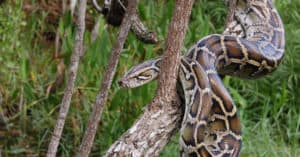Introduction
When it pertains to the fascinating world of serpents, couple of species catch the creative imagination rather like the infant tiger snake. Understood for their unique pigmentation and powerful venom, these serpents are an essential component of Australia's distinct environment. In this extensive article, we will certainly look into numerous facets of infant tiger snakes, including their behavior, environment, and how to securely connect with them. Whether you're a wild animals enthusiast or merely curious regarding these animals, comprehending baby tiger serpents can help cultivate a deeper appreciation for nature.
Baby Tiger Snakes: What You Need to Understand About Their Habits and Habitat
What Are Baby Tiger Snakes?
Baby tiger snakes are adolescent forms of the very poisonous varieties understood medically as Notechis scutatus These snakes are mainly located in seaside areas of Australia, particularly in Tasmania and southerly Victoria. As they grow, their pigmentation modifications from a much more muted scheme to the particular yellow and black bands that provide their name.
One remarkable aspect of child tiger serpents is their dimension; hatchlings generally determine around 25-30 centimeters in length. Regardless of their little stature, they possess an unusual quantity of poison that can be harmful to people if bitten.
Physical Characteristics
Tiger serpents have numerous crucial physical attributes:


- Coloration: The distinctive banding pattern commonly ends up being extra noticable as they mature. Size: Grownups can get to sizes of as much as 2 meters. Body Shape: They have a robust body that helps in swimming and earthbound movement.
Where Do Baby Tiger Snakes Live? Recognizing Their Habitat
Understanding the environment preferences of baby tiger serpents is essential for both conservation initiatives and public safety. These snakes grow in different environments:
- Wetlands: Marshes and swamps offer sufficient searching grounds. Coastal Regions: Typically located near beaches where they can hunt for prey. Woodlands: Dense plant life uses cover from predators.
Geographical Distribution
Tiger serpents are mostly found along Australia's southerly coast, consisting of:
- Tasmania: Home to one of the most infamous populations. Victoria: Particularly in locations near water bodies.
Are Tiger Snakes Venomous? A Deep Study Their Venom
One typical concern develops when discussing baby tiger serpents: "Are tiger snakes poisonous?" The solution is a resounding yes!
Venom Composition
The poison of tiger serpents consists of neurotoxins that can cause paralysis, coagulopathy (blood clotting problems), and potentially death if unattended. Right here's what you need to know:
- Effects on Humans: A bite from a tiger serpent can result in symptoms like swelling, discomfort at the bite website, nausea or vomiting, and also respiratory failure.
Comparison with Other Venomous Snakes
In contrast to various other Australian serpents such as the eastern brown snake or king brownish snake, tiger serpent poison is thought about amongst the most potent. Nonetheless, casualties are uncommon as a result of better clinical therapies and accessibility to antivenom.
Behavioral Patterns of Infant Tiger Snakes
Understanding how child tiger snakes act is critical for those Australian snake facts who stay in or visit areas where these reptiles are prevalent.
Nocturnal Habits
Most infant tiger snakes exhibit nocturnal habits. They have a tendency to forage for food during cooler night temperatures. This versatility assists them stay clear of killers while improving their hunting efficiency.
Hunting Techniques
Their hunting strategies consist of:
- Ambush Predation: Waiting inactive until target comes close. Active Foraging: Actively moving with plants or along waterways searching for food.
First Help for Snake Bites: What You Need to Know
Despite being interesting creatures, encounters with baby tiger snakes can result in hazardous scenarios if bites take place. Recognizing first aid procedures can save lives.
Immediate Steps After a Bite
Remain calmness; panic increases heart rate. Immobilize the affected limb making use of a splint or bandage. Seek immediate clinical interest-- antivenom may be necessary.Creating a Snake Bite First Aid Kit
A well-prepared first aid set should consist of:
|Thing|Objective|| ------------------------------|--------------------------------------|| Compression bandage|To immobilize the limb|| Splint|Maintains busted bones or joints|| Antihistamines|Alleviates allergic reactions|| Emergency situation get in touch with numbers|Quick accessibility during emergency situations|
Common Myths About Tiger Snakes Debunked
Many myths surround these interesting reptiles; allow's make clear some false impressions typically held by people.
Myth # 1: All Tiger Snakes Are Aggressive
While some individuals may exhibit protective habits when intimidated, not all tiger snakes display screen aggression in the direction of people unless provoked.

Myth # 2: Infant Tiger Snakes Are Much Less Dangerous Than Adults
This misconception could not be additionally from the truth! Baby tiger serpents include nearly as much venom as adults about their size; hence they pose significant dangers if bitten.
FAQs Regarding Child Tiger Snakes
What do child tiger snakes eat?- They mostly consume little animals, birds, frogs, and fish.
- Look for slender bodies with faint banding patterns that become extra obvious as they mature.
- Yes! Birds of prey and bigger reptiles might target them.
- Typically every couple of weeks as they grow rapidly throughout their early life stages.
- While some individuals do maintain them illegally without permits because of their dangerous nature; it's generally not advised provided their venomous status.
- With prompt medical therapy-- consisting of antivenom-- the survival price is high!
Conclusion
In recap, comprehending infant tiger serpents-- what they consume, where they live, just how they act-- can furnish us with useful knowledge concerning these remarkable yet harmful creatures. The relevance of education surrounding first aid procedures can not be overstated; knowing just how to react successfully after a bite can conserve lives while fostering regard for our slithering next-door neighbors within Australia's rich biodiversity spectrum.
By appreciating these serpents' duties within ecological communities-- and acknowledging possible risks-- we promote conjunction instead of fear-based responses towards each other's presence in nature's grand tapestry! Whether you're a devoted hiker considering your following adventure or just interested regarding neighborhood wild animals encounters near home-- this guide serves as your relied on reference point on the enigmatic world occupied by our pals-- the stunning baby tiger snake!